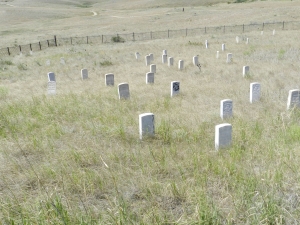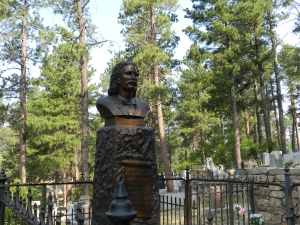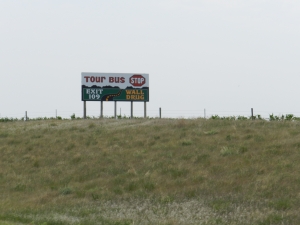National monuments - in more ways than one
We were now a whole day ahead of schedule, and we would spend it in South Dakota. Exactly what we would do, we had not decided yet, but we were sure that we would figure something out.
At 10 AM we left Billings and headed further east on I-90. Not far east of Billings the interstate turns south and so did we. The interstate passes through the Crow Indian Reservation, and at "the capital" of the reservation, Crow Agencywe left the interstate for a while.
We visited George A. Custer and met a helpful lady
 A
few miles from Crow Agency you find Little Bighorn Battlefield National
Monument, and we wanted to visit this place. It was here lieutenant colonel George
Armstrong Custer (Major General at the end of the Civil War) made his famous
"last stand" on June 25th 1876. Custer's troops met with and attacked a much
stronger force of Sioux, Cheyenne and Arapaho Indians. Custer's so-called "last
stand" took place on a hilltop, now called Last Stand Hill, where a monument is
erected. The actual battle that was later called "the last stand" lasted less
than half an hour, and when it was over, Custer and about 220 soldiers were
wiped out.
A
few miles from Crow Agency you find Little Bighorn Battlefield National
Monument, and we wanted to visit this place. It was here lieutenant colonel George
Armstrong Custer (Major General at the end of the Civil War) made his famous
"last stand" on June 25th 1876. Custer's troops met with and attacked a much
stronger force of Sioux, Cheyenne and Arapaho Indians. Custer's so-called "last
stand" took place on a hilltop, now called Last Stand Hill, where a monument is
erected. The actual battle that was later called "the last stand" lasted less
than half an hour, and when it was over, Custer and about 220 soldiers were
wiped out.
We visited the visitor center and went for a walk in the area, and saw the
memorials of both the whites and indians who participarted in the battle. On the
hillside, stones show where the dead soldiers were later found. It is not
tombstones, as the soliders were not buried on the spot, but were moved to a
national cemetary, within the borders of the national monument, where they were
buried with other soldiers, that fell on the western frontier. Custer's body was
transported east, and his grave is at the Military Academy at West Point, New
York. When we had seen enough, including the very pretty park ranger (presently
far ahead in the "prettiest park ranger we have seen so far" competition), we
returned to the interstate.
We crossed into Wyoming, and after a brief stop in Sheridan to do some shopping,
we continued south and then east towards South Dakota. In the town of Moorcroft,
approx. 50 miles from the South Dakota border, we left the intersate once more
to drive north along some minor roads. We would like to see Devil's Tower, a
strange mountain just "standing around". "Devil's Tower" was America's first
National Monument, designated as such by President
 Theodore
Roosevelt in 1906. The mountain is on a relatively flat plateau and extends 386
meters into the air. Not just the mountain, but also the road was quite exciting.
Along the way we were, like any other places in the United States, warned of
animals on the road in the form of a sign with a leaping deer. Here, however, it
became a reality because a deer ran across the road in front of the car, took an
elegant leap over a fence, and disappeared into the woods. Returning to the
interstate we passed the small town of Sundance. In this town a man named Harry
Alonza Longabaugh was imprisoned in 1888 for stealing a horse, a saddle and a
gun from a local ranch. He was caught and sentenced to 18 months in prison.
After being released, he joind Butch Cassidy's Wild Bunch and became known as
"The Sundance Kid". At Sundance we entered I-90 once more as we went across the
border to South Dakota. After the border, we continued another 30 miles to a
town called Sturgis.
Theodore
Roosevelt in 1906. The mountain is on a relatively flat plateau and extends 386
meters into the air. Not just the mountain, but also the road was quite exciting.
Along the way we were, like any other places in the United States, warned of
animals on the road in the form of a sign with a leaping deer. Here, however, it
became a reality because a deer ran across the road in front of the car, took an
elegant leap over a fence, and disappeared into the woods. Returning to the
interstate we passed the small town of Sundance. In this town a man named Harry
Alonza Longabaugh was imprisoned in 1888 for stealing a horse, a saddle and a
gun from a local ranch. He was caught and sentenced to 18 months in prison.
After being released, he joind Butch Cassidy's Wild Bunch and became known as
"The Sundance Kid". At Sundance we entered I-90 once more as we went across the
border to South Dakota. After the border, we continued another 30 miles to a
town called Sturgis.
At that time we were running out of clothes, so we decided to find a motel with a guest laundry, and then spend the afternoon doing laundry. We found a motel allright, and immediately after having carried the luggage to our room and sorted the laundry, we went down to do some washing. Here we were overwhelmed with another kind of national monument, namely the American helpfulness. It turned out that you had to pay for the use of washing machine and dryer at the front desk so we turned to the lady who where on duty. She told us that it would cost us two dollar to wash all out clothes and the same for drying it. This was around half price of what we were used to, and for another dollar we bought detergent enough for all the clothes that we were going to wash. In the laundry there was one washing machine and one dryer, but the lady said that we should just wash all our clothes (two machines full), and then we could put it all in her large dryer when we were done washing in stead of having to wait for the smaller dryer in the laundry. We filled up the washing machine and before going up to our room I asked the lady how long it took, and she said half an hour. When we got back down to the laundry half an hour later, the machine had finished. The lady came rushing with a laundry basket on wheels where we could put our clothes until the next load was done too. Half an hour later we came back down and found the washing machine empty and the basket gone. The lady came out from the front desk and asked us to get into the back room, where two very large dryers was well under way, and the clothes in the one was actually already dry. The lady had put the first clothes to dry, and when the second round was finished, she had thrown it into the second tumbler. Now, she helped us take it out, and while she returned to her desk to serve some other customers, we folded out clothes. When the clothes in the second dryer was finished, she helped to fold it, and had we asked, I'm certain that she would have packed the suitcases too :-). That is what I call service!
A visit to the wildest of the Wild West
From Sturgis to the next day's
goal in Wall, South Dakota, there are only about 50 miles, so we had a
relatively good time to see more than just the interstate - and so we did. We started
the day by heading back west by I-90 to the town of Spearfish. From here we
drove south to Deadwood. This town was one of the most notorious towns in the days when the Wild West was really wild. We drove through the historic district,
which was nice, but no more than that, and anyway it was not the goal of the
visit. In the 1870s the town was bustling. Gambling, booze, opium trade and
working girls were common, in addition to cheating gold miners in the Black
Hills out of the little money, most of them made from their digging. Among the
town's celebrities from that time, were the gambler and brothel madam, Eleanore
Dumont or Madame Mustache, who was actually a woman,
and Wyatt Earp who lived in the town for a while.
T he
town is probably best known because it was in Nuttall & Mann's Saloon that James
Butler "Wild Bill" Hickok was shot in the back on the 2nd of August 1876, a few
months after Custer's Last Stand. Also Martha Jane Canary-Burke, better known as
Calamity Jane spent some time in town. After Wild Bill's death she claimed that
they had been married, and when she died, her last words were: "Bury me next to
Wild Bill". Her body was taken to Deadwood and she was actually buried next to
Wild Bill Hickok. It was the graves of Wild Bill and Calamity Jane, that we
wanted to see, so we drove up to Mount Moriah Cemetery on a hill above the city.
Here we paid the incredible sum of one dollar each to gain access to the
cemetery, where we saw the two graves with their signs. At Wild Bill's grave a
bust of the man got Tim to exclaim that "a man with such a mustache had deserved
a better fate". The man who shot Wild Bill, John "Broken Nose Jack" McCall was
later convicted on two occasions and hanged for murder.
he
town is probably best known because it was in Nuttall & Mann's Saloon that James
Butler "Wild Bill" Hickok was shot in the back on the 2nd of August 1876, a few
months after Custer's Last Stand. Also Martha Jane Canary-Burke, better known as
Calamity Jane spent some time in town. After Wild Bill's death she claimed that
they had been married, and when she died, her last words were: "Bury me next to
Wild Bill". Her body was taken to Deadwood and she was actually buried next to
Wild Bill Hickok. It was the graves of Wild Bill and Calamity Jane, that we
wanted to see, so we drove up to Mount Moriah Cemetery on a hill above the city.
Here we paid the incredible sum of one dollar each to gain access to the
cemetery, where we saw the two graves with their signs. At Wild Bill's grave a
bust of the man got Tim to exclaim that "a man with such a mustache had deserved
a better fate". The man who shot Wild Bill, John "Broken Nose Jack" McCall was
later convicted on two occasions and hanged for murder.
When we had completed our visit at the cemetery we drove south from Deadwood. We
would visit Danish-American Gutzon Borglum's famous presidential sculptures at
Mount Rushmore. As we approached the entrance to the site, which is also a
National Monument, just as Devil's Tower others were queuing far along the main
road, and it looked as if it would take several hours just to get into the
parking lot. We drove past the site and turned around about two miles further on.
Back at the site of Mount Rushmore we stopped and took pictures from a pull out
at the road, where photo opportunities were great. We had thus seen the monuments,
albeit at a distance. Zoom lenses are a great invention!
When we had taken enough pictures we followed U.S. 16 to Rapid City and then
again I-90 to the goal of the day in Wall, where we arrived around 12.30. Here
we passed yet another "national monument", although the place is not recognized
as such. I'm talking about "Wall Drug Store", where free ice water had been
offered since the 1930s. From Wall we proceeded to a genuine national monument,
or rather national park, which is little "upscale" from a national monument,
although they may look similar :-) It is the degree of protection that makes the
difference - and the fact that the president himself can designate national
monuments, while national parks must be approved by Congress. More precisely, we
drove to Badlands National Park, where one of the entrances is located only a
few miles from Wall.
Badlands consists primarily of eroded rocks of different flavors that gives the
place a "wild" appearance, as the name suggests. The National Park is home to
many different animals, including the black-footed ferret, the most endangered
species of all mammals in the United States, and of course we saw none of those.
It was also in the area where now Badlands National Park is, that the "Ghost
Dance movement" began in 1890, inspired by a Paiute indian by the name of Wovoka,
called "The Prophet". The movement was immediately declared illegal because the
whites thought that it encouraged Indians to fight against them. That same year,
the famous Hunkpapa Sioux chief Sitting Bull was accused of being the leader of
the movement and killed. Another supporter of the movement was Chief Big Foot.
In December the same year, he and 153 members of his tribe, mostly women and
children, were massacred at Wounded Knee, 30 miles south of Badlands, and the
movement disappeared, but it all started then in the Badlands. And so did we.
 We
followed the "main road" east through the park and stopped at several pull-outs
and parking lots to enjoy nature and take pictures of it. Pictures of rock
formations, colored cliffs overlooking grassland, pictures of fossils of long
extinct animals and so on. When we reached the easternmost end of the park, we
left the park and drove back west on South Dakota State Road 377. It runs in a
kind of no man's land between the northern and the southern part of the national
park, but is not inside the park. South of the road is Pine Ridge Indian
Reservation, home of the Oglala Sioux tribe, but there is only one way through
this part of the park, and it leads to the south, which was not our goal.
Instead, we continued west until we reached an unnumbered road to the north,
which would lead back to the western part of the park's northern area. On we
went and it turned out to be a dirt road. After 20 miles along this, we re-entered
the national park. On the way we saw some cows and inside the park, we saw a
herd of bisons in the distance. The dirt road continued for about 7 miles, and
then we exited the park once more and drove along paved roads the 5 miles back
to Wall.
We
followed the "main road" east through the park and stopped at several pull-outs
and parking lots to enjoy nature and take pictures of it. Pictures of rock
formations, colored cliffs overlooking grassland, pictures of fossils of long
extinct animals and so on. When we reached the easternmost end of the park, we
left the park and drove back west on South Dakota State Road 377. It runs in a
kind of no man's land between the northern and the southern part of the national
park, but is not inside the park. South of the road is Pine Ridge Indian
Reservation, home of the Oglala Sioux tribe, but there is only one way through
this part of the park, and it leads to the south, which was not our goal.
Instead, we continued west until we reached an unnumbered road to the north,
which would lead back to the western part of the park's northern area. On we
went and it turned out to be a dirt road. After 20 miles along this, we re-entered
the national park. On the way we saw some cows and inside the park, we saw a
herd of bisons in the distance. The dirt road continued for about 7 miles, and
then we exited the park once more and drove along paved roads the 5 miles back
to Wall.
Here we finally visited the famous drugstore. It was founded in 1931 and it was
not doing too good until the couple who ran it, got the brilliant idea to put up
signs at the main road, where they advertised free ice water. It made the
motorists flock at the drugstore. It was hot in the area, and there was no air
conditioning in cars in the 1930s, so the ice water was heavensent. The
drugstore survived and is today run by the same family. Free ice water is still
served , but things are different from 1931. Today there is a restaurant on
site, several souvenir shops inside the drugstore that sells clothes and lots of
other goodies. Around the drugstore has arisen an entire business district with
restaurants and souvenir shops, but we didn't visit any of those. The signs that
were originally put up along the main road, is long gone. On the other hand,
there are plenty of new signs along I-90, from the Wyoming border advertising
offers from Wall Drug.
-
Return to Cross Country Tour -
- Return to
Travel stories -